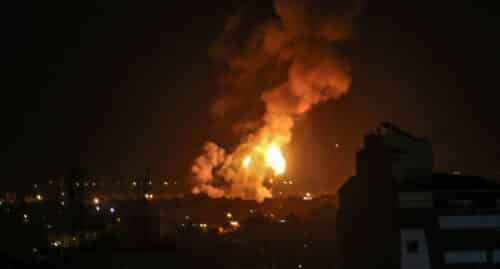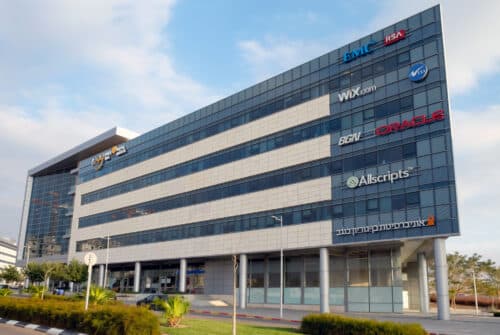The atrocities committed by Hamas and Islamic Jihad terrorists on “Black Saturday“, on October 7 were cruel and inhumane. We were all shaken to the core and appalled by the images, and wondered how could this even be possible? How could a human being commit such heinous atrocities to another human? One possible – partial – explanation to this was found on the bodies and in the personal gear of the terrorists – of bags with hundreds of pills of a drug named Captagon, which likely boosted the terrorist’s bloodthirsty frenzy and ability to commit such atrocities while under the influence.
Inspired by the Nazis
If anyone had any doubt that the Hamas terrorists are a modern semblance of the Nazis, here is a piece of history that shows where these terrorists drew inspiration:
In World War 2, the Nazis used drugs – mainly the methamphetamines Pervitin and Isophan– that were nicknamed “Hermann Goering pills” by the Wehrmacht tank crews.
Those “courage pills” were used as stimulants and inspired a heightened sense of confidence among the troops, and served the Third Reich’s obsession with physical and emotional supremacy.
Already in the Nazi invasion of Poland on September 1939, the Wehrmacht’s military physicians prescribed Pervitin to the German troops. In this battle that bread the term “Blitzkrieg”, or blitz war, two elements were viewed as paramount for victory: speed and surprise, catching the enemy unprepared and swiftly acting on that advantage. However, battle fatigue was a hindrance to the full execution of this doctrine, slowing the Nazi invasion. This is the point where Pervitin came into play.
With a powerful relentless Blitzkrieg, assisted to a great extent by these stimulants, the Nazis stormed like a wildfire through Denmark, Norway, The Netherlands, Belgium and finally France. The Wehrmacht paratroopers were described by the British press as “heavily drugged, fearless and crazed”.
Winston Churchill, British Prime Minister during World War II, even wrote in his memoirs:
“’I was dumbfounded’…The speed of the attack was jaw-dropping. High on Pervitin, German tank and artillery drivers covered ground night and day, almost without stopping. Foreign commanders and civilians alike were caught entirely off guard.”
Now, as in the events of the Nazi atrocities and aggression, the power of these hard drugs left its impression on those who’ve had the misfortune to witness their effects. In a chilling resemblance to the Nazi drugged troops, testimonies from the October 7 massacre survivors speak of terrorists with a cold, detached and vicious look in their eyes.
What is Captagon?
Captagon, also known as the “cocaine of the poor,” “ISIS’s drug” and the “jihad drug,” is a drug that contains a synthetic stimulant from the amphetamine family called phenylene. In the past, the drug was used to treat ADHD, but due to concerns over its addictive properties, the drug’s use was discontinued. Captagon induces extremely high levels of energy and suppresses the need for sleep enabling the user to operate intensively for hours and even days, and creates a feeling of euphoria and suppresses appetite. This is one possible motivation for the use of the drug by Hamas: by using Captagon, terrorists would be able to spend long hours without the need for sleep or food, while staying in Israeli territory, committing atrocities and capturing hostages.
However, Hamas neither discovered nor developed Captagon. It was widely used by ISIS terrorists and is trafficked and sold by Hezbollah’s narco-terrorist 320 billion dollar per year worldwide cartel. Investigation of the deadly Paris terror attack in 2015 revealed that the terrorist took Captagon in their hotel room right before the attack. The probable objective in using the drug was to induce a sense of euphoria and emotional detachment. Testimonies from survivors of the Paris attack mention that the terrorist acted like zombies and were oddly detached.
ISIS was not the first either to discover or use the drug. The “jihad drug” has been in use by the Hezbollah for decades, and the organization has been manufacturing and trafficking it around the entire Middle East. Hezbollah is considered one of the largest narco-terror groups in the world, with funding arriving not only from Iran but in no small amount also from the terror organization’s drug and money laundering business.
One main problematic center of Captagon distribution is the Kingdom of Saudia Arabia. Captagon is especially prevalent among the youth in the KSA, who in Captagon have found a substitute to alcohol, which is forbidden according to Islam. KSA is one of many countries with a growing Captagon problem and it is essentially considered the Ecstasy (MDMA) of the Arab world and regional terror organizations.
How has Captagon become the “drug of Jihad”?
Captagon was first manufactured in 1961 by a German company by the name of Degussa – the very same company that also developed Zyklon B used in the gas chambers in the Nazi extermination camps. After being discovered to be highly addictive, Captagon was outlawed in most Western countries.
Since one of the properties of the drug is the suppression of fear, it had become a drug of interest for terrorist organizations across the Arab world. In the wake of the Second Lebanon War in 2006, Lebanon became an empire of counterfeit medicines. Hezbollah, which was severely damaged after the war, was also at a point where funds were desperately needed. So, who stepped in to take advantage of the situation and “come to the aid” of the murderous organization? The same “patron” from Tehran which had been nurturing Hezbollah throughout the years as its favorite and closest proxy. The Iranians could not leave Hezbollah in a ruinous state and had to stabilize the organization after the war in order to continue furthering their regional interests. However, rather than supplying Hezbollah with a suitcase full of cash, Iran sent machines – machines to manufacture counterfeit Captagon as a means with which to generate the needed funds. As many businesses in postwar Lebanon delt in the trade of counterfeit materials and products, Hezbollah discovered that the machines it now had in its possession – are literally money-printing machines.
However, the issue of religion presented a problem. The trafficking and use of drugs are prohibited under Islamic law – the Sharia. But Hezbollah General Secretary Nasrallah and his organization were relentless and found a loophole of sorts in Sharia law that enabled them to legitimize the use of Captagon: they came up with a whitewash decision that since Captagon was not a genuine drug, but a counterfeit, its distribution therefore was permitted. In 2011, the Kuwaiti newspaper El-Siyasa reported that Tehran’s Supreme Leader Ali Khamenei had issued a secret fatwa at Nasrallah’s request that legitimized the counterfeit pharmaceutical industry in Lebanon. Since then, millions of dollars have been rolling off of Hezbollah’s Captagon machine. However, the fatwa was given on one opportune condition: that the Captagon would not be sold to Shiites such as the Hezbollah and Iran, but only to their Sunni rivals and other elements. From that point on, the ersatz drug was sold in commercial quantities in Muslim Sunni countries, such as Saudi Arabia, also reaching the hands of Hezbollah’s enemies – ISIS, the Salafist-Sunni organization. If you will, Captagon plays a central role in the Sunni-Shiite rift, and is deliberately distributed to Sunni elements in the region (including Hamas, a Sunni organization – a product of the distinctly Sunni Muslim Brotherhood movement).
It is worth mentioning that Captagon, as manufactured by Hezbollah, contains components that are much cheaper to produce than the original drug, which plays a central role in the Sunni-Sh’ite rift in the sense that Shi’ites manufacture cheap material that drugs Sunnis, making profit off of their suffering.
Captagon was smuggled in various forms, with routes used by many mixed nationality Arab smuggling groups including Syrians, Lebanese, Palestinians and others. It was only a matter of time until terrorist organizations and extremist jihad groups got their hands on Captagon.
The Syrian civil war changed the rules of the game and ratcheted up the distribution of Captagon, creating distribution “on steroids” – thus it was not long before all sides of the Syrian civil war were on Captagon to enhance their performance in the battlefield.
The drug of war
Hezbollah, an organization with a well-developed sense of business, seized the opportunity and established the production of counterfeit Captagon in Syria. Soon, the drug began to permeate into all the elements involved in the fighting in Syria, including Jabhat al-Nusra, rebel militias, Assad’s army and ISIS – and even Hezbollah operatives, despite the Shiite religious prohibition.
Everyone recognized the potential of the drug and the fact that its cheap production and sale to countries in the region could finance the continuation of the fighting.
With Syria was on the brink of total disintegration, and the Assad family search for creative ways to maintain a steady cash flow –Hezbollah’s business model fit like a glove.
Welcome to ‘Narco-state’
Captagon laboratories in Syria began churning out the drug around the clock. According to assessments by foreign sources, Captagon laboratories in Syria are concentrated mainly in the cities of Homs and Daraa (right next to the Jordanian border), and in the rural areas of the port city Latakia (considered a stronghold of support for the Assad family) in the north of the country.
The labs mostly operate in abandoned factories or abandoned villas, with soldiers from the Syrian army’s Fourth Division positioned around the labs and with “closed military area” signs around the entire perimeter.
Captagon pills are sent out from these makeshift factories to packaging facilities, where they are packaged and hidden in various goods, and sent on to the port of Latakia or to the land borders under the guise of legal goods.
In addition, Syria sits at a strategic commercial crossroads that on the one hand allows access the Mediterranean Sea – and from there by sea to Europe – and on the other hand it shares very long land borders with Iraq and Jordan, making it easier to ship goods to rich Arab countries, such as Saudi Arabia and the Gulf states.
It is no mere coincidence that the main targets for Syrian Captagon shipments are Saudi Arabia and the Gulf states. These countries have higher socioeconomic demographics as compared with other Arab countries. Another reason is the strict Sharia laws in these countries such that do not allow the sale of alcohol to locals, and they seek substitutes, and Captagon fills the bill.
Captagon’s shipments from Syria generate billions of dollars used for the purposes of terrorist organizations, and help the Assad regime keep its head above water, making Syria the main supplier of the “jihad drug” to the KSA.
Hezbollah also plays an important role in the Captagon industry (although the leading role in drug production has shifted to Syria): the Shiite organization controls the border crossings in the Beqaa Valley, and thus controls the supply of raw materials into these improvised factories in Syria and their distribution by Beirut’s sea and air ports.
It should be noted that drug smuggling from Lebanon to Saudi Arabia has led to a serious crisis in relations between the two countries. In April 2022, 5 million Captagon pills were found inside a shipment of grenades arriving to Saudi Arabia from Lebanon. The Saudis were furious and announced that they were forbidding the import of all goods from Lebanon, hinting at Hezbollah’s involvement in the smuggling.
In general, Saudi Arabia is considered the country most afflicted by the use of Captagon.
However, it is not only the wealthy Persian Gulf and Sunni Arab states which are in the crosshairs. Huge Captagon shipments were also seized in Italy, Greece and Malaysia, meaning that other Muslim countries, European countries and the rest of the Western world are also in the crosshairs of the “narco–jihad”.
In recent years, the drug has also become popular in the Gaza Strip with tens of thousands of addicts, especially among young people caught in the unemployment cycle. The French newspaper Le Figaro revealed that the smuggling of Captagon drugs from Syria into the Gaza Strip has doubled through the border crossings, and the volume of sales of the drug has increased immeasurably compared to other drugs considered popular in the Gaza Strip, such as hashish and Tramadol.
Despite Israel’s boycotts as part of its counter-drug smuggling effort, smuggling operations are carried out unhindered at the Rafah Crossing, with trucks passing through it on a daily basis (including shortly before the war) with aid for Gaza residents.
The main supplier of the Captagon drug today is Bashar al-Assad and his malicious regime. Militias operating under Assad’s auspices deal in drug production and trafficking to supplement the country’s revenues in the wake of the war and to pay off large debts to Russia and Iran. Assad’s relatives use the ports of Tartus and Latakia in Syria to ship and smuggle the drug by sea as well.
In conclusion, Captagon is found in Gaza, arriving there on a daily basis. Its low price, popularity in the population, and properties conducive for combat are qualities that appeal to terrorist organizations. With that said, it is important to realize that the cruelty and heartlessness of terrorist organizations such as Hamas cannot be solely attributed to Captagon alone, as these atrocities would not be possible without systemic, methodic and continuous brainwashing and radical incitement of these organizations.
Another thing about the bags of Captagon pills found on the Hamas and PIJ terrorists in the wake of the horrific massacre on October 7, is proof of the ongoing connection and the utilization of terrorist MOs and know-how provided by Hezbollah and Iran to the terrorist organizations in the Gaza Strip – namely Hamas and the Islamic Jihad. This all is part of Iran’s guidance to realized its intentions, thus sharing methods and strengthening the capabilities of these proxy organizations and making them into proxies “on steroids”.
It can be assumed the IDF ground forces that go into Gaze will have to fight Hamas terrorists hyped up on Captagon.






